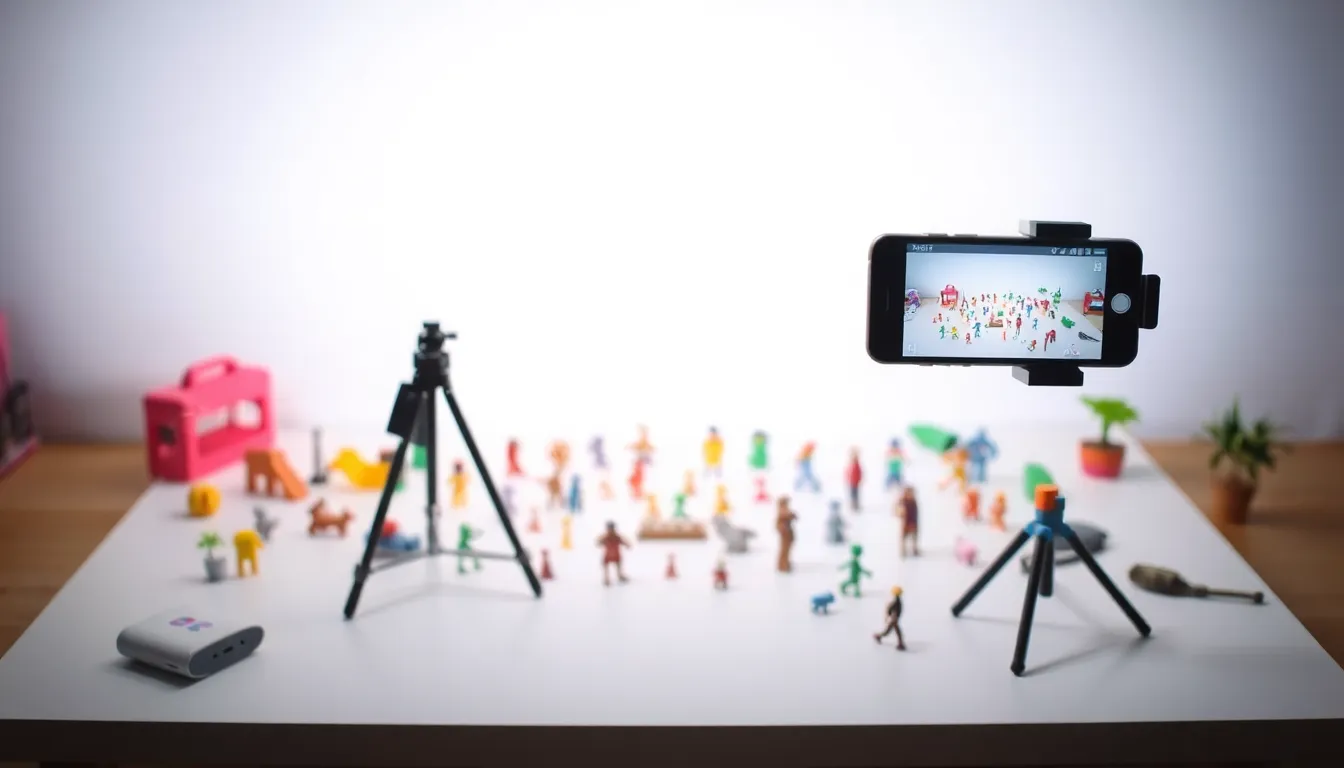Table of Contents
ToggleStop motion is like magic, turning everyday objects into animated stars with just a few clicks. Imagine your coffee cup doing a little dance or your pet taking a stroll—it’s all possible with your iPhone! This powerful little device isn’t just for scrolling through social media; it’s a mini studio waiting for your creative touch.
Tools Required For Stop Motion
Creating stop motion animation on an iPhone requires specific tools for optimal results. Users can enhance their animations with the right apps and accessories.
Recommended Apps
Numerous apps streamline the stop motion process. Stop Motion Studio provides a user-friendly interface along with editing features. iMotion offers extensive control over timing and frame rates. Lifelapse caters to beginners with its simple layout and instructional content. Animation Studio allows for robust features like layering and audio integration. Each app supports iPhone’s capabilities, making animations easier to produce.
Additional Accessories
Several accessories improve the stop motion experience. A sturdy tripod ensures stability, preventing unwanted camera movement. Lighting kits offer consistent illumination, enhancing the visual quality of the scenes. Backdrops create a polished look, helping to define the setting. Using a remote shutter release simplifies taking shots without shaking the phone. These tools collectively elevate the quality and efficiency of stop motion projects.
Getting Started With Stop Motion

Creating captivating stop motion animations begins with a well-prepared setup. Set the stage for creativity and visual storytelling through thoughtful scene arrangement.
Setting Up Your Scene
Choose a location that minimizes distractions. Use a clean and flat surface to fit your storyboard. Arrange props and characters, ensuring alignment for consistent shots. Consider employing backdrops that enhance the theme. Lighting plays a crucial role; adjust angles to eliminate harsh shadows. Test the setup by taking a few shots to ensure everything appears as intended.
Preparing Your iPhone
Select a stop motion app that aligns with your needs. Popular choices include Stop Motion Studio, iMotion, and Lifelapse. Ensure the app is downloaded and updated for seamless performance. Adjust camera settings to optimize quality by setting the focus and exposure manually. Mount the iPhone securely on a tripod for stability during filming. Additionally, activate “Do Not Disturb” mode to prevent interruptions. Check battery levels and ensure plenty of storage is available for your animations.
Creating Your Stop Motion Animation
Creating stop motion animation on an iPhone involves planning and execution. Users can turn their ideas into engaging visuals by following a few straightforward steps.
Capturing Frames
First, position your iPhone securely on a tripod. Stability boosts frame quality and reduces shake. Next, use the chosen app to capture each frame. Single shots or bursts can work effectively. Move your subject slightly between frames for a smooth transition. The app typically provides a preview option for reviewing your progress. Consistent lighting contributes to a polished look, so adjust the light as needed. Keep your scene organized and your focus sharp to maintain the overall clarity of the animation. Capturing multiple frames ensures the final product flows seamlessly.
Editing Your Animation
Editing enhances the final animated sequence. Begin by importing frames into your preferred app. Many applications offer options for arranging and selecting frames efficiently. Users can trim any unnecessary shots to maintain pacing. Adding sound effects or music can enrich the animation’s appeal. Adjusting the frame rate alters the speed for a more dynamic presentation. Utilize filters or visual effects as desired, but avoid overwhelming the primary content. Once satisfied, export the final product directly to your camera roll or share it on social media platforms. This streamlined process makes it simple to create impressive stop motion animations.
Tips For Successful Stop Motion
Effective stop motion animation relies on several key factors. Following best practices in lighting and frame rate enhances the overall quality of the final product.
Lighting Considerations
Lighting plays a crucial role in stop motion animation. Natural light provides a soft and even quality, making it ideal for indoor settings. Users may consider using artificial lights for consistency, especially when filming over extended periods. Position lights to eliminate shadows and ensure even illumination across your scene. Softboxes or LED panels offer excellent options for achieving the right effect. Keeping light sources stationary prevents flicker and maintains a uniform look throughout the animation. Brightness adjustments can also help avoid overexposure or underexposure, allowing for clear visuals that convey the intended mood.
Frame Rate Suggestions
Frame rate directly impacts the smoothness of stop motion animations. A standard frame rate for fluid motion is 12 frames per second (fps), which results in a seamless experience for viewers. Some animators prefer using 24 fps for a more cinematic effect, producing a highly polished animation. Capturing more frames can enhance detail and provide a smoother transition between movements. Additionally, experimenting with frame rates can yield unique artistic styles. Users are encouraged to balance frame rate choices and subject movement for the best outcome, ensuring that each frame contributes effectively to the story being told.
Common Challenges and Solutions
Creating stop motion animations on an iPhone can present various challenges. One common issue is achieving consistent lighting. To address this, users should utilize multiple light sources to minimize shadows and maintain even illumination throughout their scenes.
Another challenge involves camera stability. Movement can disrupt the animation’s flow, resulting in choppy visuals. Securely mounting the iPhone on a tripod can mitigate this issue, ensuring that every frame maintains the same perspective.
Frame rate confusion often occurs during the editing stage. Users might struggle with selecting the right frame rate for their animations. Sticking to standard rates, such as 12 frames per second for smooth motion, fosters improved visual appeal, while experimenting with 24 frames per second can create a cinematic effect.
For those dealing with time constraints, limited shooting sessions can hinder creativity. Planning and storyboarding the scenes before filming helps optimize shooting time. This preparation can also aid in ensuring the narrative flows seamlessly.
Editing poses its own set of challenges. Managing numerous frames can lead to complexity. Users can simplify this process by organizing frames into folders or using labeling features within the app, making it easier to select and edit the desired clips.
Additionally, distractions during filming can interrupt the animation process. Activating ‘Do Not Disturb’ mode on the iPhone minimizes interruptions from notifications. This setting allows the creator to focus solely on capturing frames without outside interference.
Issues with app functionality may also arise. Users should ensure that their chosen stop motion app is consistently updated to access the latest features and enhancements. Regular updates often resolve bugs that could disrupt the animation workflow.
Creating stop motion animations on an iPhone opens up a world of creativity. With the right tools and techniques anyone can transform everyday objects into captivating stories. By utilizing recommended apps and accessories users can enhance their projects while ensuring stability and quality.
The process encourages experimentation with lighting and frame rates to achieve the desired effect. Overcoming common challenges like maintaining consistent lighting and camera stability is key to producing smooth animations. With careful planning and attention to detail anyone can bring their imaginative ideas to life and share them with the world. Embrace the journey of stop motion animation and let creativity shine.





